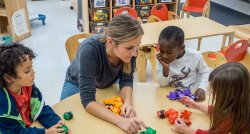What we want our students to know and be able to do:
- Understand, analyze and apply various principles and global perspectives of child development to enhance the care and well being of all children.
- Implement culturally responsive teaching and learning practices, assessments and dispositions.
- Identify bias (racism, sexism, homophobia, etc.) and intolerance in teaching practices, materials, websites, etc. and ensure an anti-biased teaching and learning environment.
- Demonstrate sensitivity and sensibility toward the cultural, social and political context of families and communities, particularly those in inner cities, and reflect the knowledge, skills and dispositions necessary to work collaboratively with diverse communities.
- Implement a well-articulated constructivist philosophy of teaching and learning as demonstrated by cohesive and integrated curricular approaches, student-centered instructional strategies, varied assessment and observation strategies, critical thinking strategies, technology, building classroom community, classroom management and classroom environment (physical design).
- Demonstrate knowledge, skills and dispositions toward inclusionary practices – accommodating to the needs and abilities of individual students and families (differentiated learning, special education strategies, etc.).
- Use strategies of collaboration and advocacy to promote collegiality within the profession and to act on the moral dimensions of teaching and the demands of social justice in order to improve the lives of children and families.
- Provide shared leadership within schools, agencies and institutions that serve children and families based on knowledge of social systems and how systems work in a given community. Respect cultural competence.
- Build communities of learners based on high-quality, effective relationships that enable effective learning: knowing children and families well, appreciating strengths and differences, acknowledging and building on rich social interactions among children, etc.
- Use technology as a tool for teaching, learning, and communicating: curriculum, professional development, collaboration across school, university and community.
